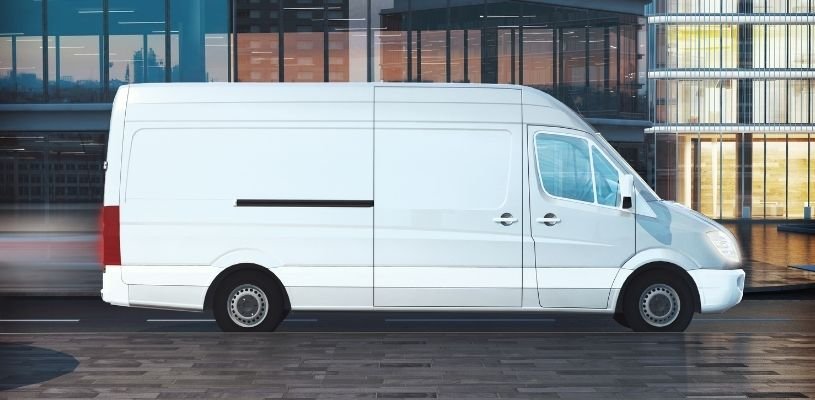
Who says that vans only provide a means of transport? By wrapping your commercial van you can not only pick your van out from a crowded car park but also be your own moving local advertisement for your business. Just like a billboard but without the monthly fees. Aside from this, the addition of a wrap can also protect your van’s paintwork against chipping and abrasion, helping to preserve its value. You may be wondering how you can vinyl wrap a van as well as the cost of wrapping it in decals and logos. Here’s how you can increase brand awareness yourself with our van wrapping guide.
What Is Vinyl Van Wrap?
Decals, lettering and logos have been vinyl wrapped since the 1950’s but it wasn’t until 1993 when full vehicle wrapping took form. Germany mandated all taxi’s to be coloured beige but with no mention of paint, Kay Premium Films vinyl made taxi’s regulation-compliant wrapped taxi with full beige vinyl wraps in a matter of hours.
A vinyl wrap is made of polyvinyl chloride or PVC polymer which gives “vinyl” its name and a mix of additives to make it flexible, resistant to UV light and give it colour.
How Much Does It Cost to Vinyl Wrap a Van?
When it comes to the cost of vinyl wrapping a van, this depends on 3 factors. The size of the van, how extensive the design is and how much of it you want to wrap. While some may want to have their entire van wrapped, others may want what is called a decal. These are van wrap designs which only cover part of a vehicle with a design such as logo or web address.
This is often chosen by businesses as it is the cheaper option, costing between £90 and £250 for a small van. This price can rise to between £650 and £700 if you wish to cover half of your van and from £850 to £1050 for your whole van.
Van wrap costs for a mid-sized van however are significantly higher. A decal of the same size will cost you around £175 to £350, between £650 to £950 for a half wrap and £1150-£1500 for a full wrap.
The van wrap cost for a large-sized van rises to between £300-£600 for a simple wrap service, £800-£1350 for half your van and a cost of between £1350 and £2500 for a full body wrap.
While there may be a high initial outlay the benefits wrapping provides far outweighs its cost, with free marketing for your business and body protection for as long as up to 10 years.
Van Wrap Ideas
The best van wrap designs are ones that have minimal text and concisely and effectively communicate your business’ offering and USPs. Van wrap design ideas in the past have been very uniform, with simple lettering and a logo. While this is fine and serves its purpose, those that are more memorable and find themselves lurking in a person’s subconscious is a design that is bright and innovative with puns or image manipulation.
How to Vinyl Wrap a Van
If this is too much of a stretch for your budget, you might want to consider wrapping your van yourself. This guide on how to vinyl wrap a van is by no means foolproof as wrapping requires a lot of manpower, skills and patience in order to be completed to a high standard. However, if you wish to wrap your van yourself, we urge you to do so with some assistance.
Given that you have all of the things you need there is no reason for why you shouldn’t be able to give your van a smart-looking makeover. The tools required are relatively easy to access and vinyl wraps today are more resilient, have better adhesive and air release technology to prevent bubbling.
This should be a low-cost, do it yourself job but just be mindful that the cost of materials will soon add up as you opt for more custom prints and finishes.
The Tools You Will Need:
-
Grease
-
Wax remover
-
A general cleaner
-
70 or 90% isopropyl alcohol
-
Lint-free cloths or towels
-
Squeegee
-
Utility knife
-
Cutting tape
-
Heat gun
-
Infrared thermometer
-
Cotton wrap gloves
-
A clean work table
Preparation
What canvas do you have to work with? Is the body smooth? Or does it have chips, dents or rust? Using a vinyl wrap can accentuate all imperfections if it sticks to them or bubble and tear if it doesn’t. Before wrapping your van, ensure to take care of all defects prior for a wrap that you are happy with and that will last you a long time.
Wrap on a warm day. Vinyl is temperature sensitive so it’s important that your vehicle and wrap are at the same temperature of around 20 °C. Any colder and the vinyl will become brittle and tear. If any hotter and the adhesive may activate too aggressively making any chance of a smooth installation difficult. To be sure that the temperature is optimal for wrapping, monitor using a non-contact infrared thermometer.
Prepare the Surface
Clean your van to allow vinyl wrap to readily bond and wipe your entire van down with isopropyl alcohol and lint-free cloths.
Remove all obstacles. Yes, you can wrap around a wing mirror, door handle, emblem or antenna but it makes the job significantly more difficult.
Measure each section that you will be wrapping carefully. Once your vinyl wrap has been cut, there is no way of adding more material if you fall short. Avoid getting into this frustrating dilemma by adding a few inches for handling. We recommend sketching a diagram of your van’s body panels with measurements to keep handy for later on. If however, you have little handling space or your panel is larger than your largest vehicle wrap, you’ll need to make a seam.
Fixing Your First Sheets of Vinyl
If you’re wrapping for the first time, start off with smaller and flatter sections to help build your confidence before taking on more challenging or sculpted panels. Using a utility knife, carefully cut the material you need according to your sketch and measurements.
Hold the vinyl in the air with your partner wearing cotton gloves. Position your vinyl ensuring that extra material is left around the edges for manipulation later on. Once you have your position, remove the backing paper without releasing tension on the wrap. This will reduce the chance of developing wrinkles and creases. Carefully stick the vinyl wrap over the panel by starting at the centre with a squeegee to force air out and create a temporary adhesion.
Smoothing Out Air Bubbles & Wrinkles
If you notice any bubbles, apply a heat of more than 80 °C with tension to stretch, fixing it into place with a squeegee. You may find this trick to be handy when wrapping curved panels and objects such as mirrors but be sure to be a little more patient.
Edging and Finishing
A great start makes for a great finish. Using the utility knife, trim any excess material 2-3 mm from an edge for a sharp, clean result. Likewise, too much material and your DIY wrap job is a dead give-away. Seal the edges using a heat gun at a temperature of at least 100 °C to activate the adhesive. With a squeegee and your fingers, firmly seal the edge to the panel. If heating you’re heating the vinyl to wrap it around a sharp groove, make sure that the vinyl cools before cutting.
Once all in place, use the heat gun on the whole van at 100 °C to activate the vinyl adhesive for a long-term bond. Use your hands and squeegee where needed to firmly bond. At this stage, bubbles may appear but can be popped safely with a pin or utility blade. Now, the final step is to wait 12 hours and allow the wrap adhesive to fully set. There you have it, how to vinyl wrap a van by yourself.
How to Remove Vinyl Wrap From Your Van
Lastly, when it’s ready for a refurb or to be sold on to its next owner, you’ll need to know how to take the wrap off a van. This is quite easy to do, only requiring a few simple tools. Start by heating the vinyl with a quick pass of a blowtorch to melt the adhesive. Something especially important to do on a cold day. Using a piece of plastic, try to get under the vinyl wrap and start to lift it away from the bodywork. Don’t worry, this won't chip your paint work. Methodically work your way around each section. Once all stripped bare, polish any adhesive residue from your van and it should be as good as new.
If you're looking for a new commercial van for business, browse our range of cheap vans online. At Nationwide Cars, we can help you save £1000’s on your new van and have finance options to help spread the cost.


